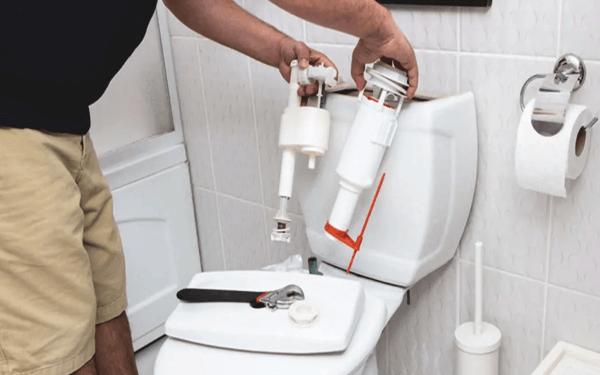Maybe you’re lying around your house, and you hear a gurgling noise. Upon investigation, it’s coming from the washroom, although it’s not in use. What could be the possible reason? Is someone using your toilet without you knowing? You’ll be relieved to know that it’s just noises your toilet is making from malfunctioning.
Is your toilet making noise when not in use? Perhaps you’re just lurking around the internet looking for solutions. This article will discuss everything related to how you can quickly solve your toilet noises.

Contents
Why Is My Toilet Making Noise When Not In Use?
There are quite a few possible reasons for your toilet making noise. Most of the time, it’s not any normal noise – it’s caused by some dysfunctionality in your toilet, whether it’s the valves or the flush.
There are three main problems which people usually struggle with. They are easy to determine. Here’s how you can quickly tell what problem you’re facing given the time interval; between the noises:
- GHOST FLUSHING: You’ll hear this sound frequently. It’ll most possibly happen in 60 minutes to a few hours. There’s just going to be a noise on the toilets own without having to press the flush.
- FILL VALVE HISS: You’ll most likely be hearing this sound when your toilet sounds like the water is being moved with force along with air.
- WATER RESONANCE: Water resonance is one of the most common problems people face, caused by flushing. The toilet will sound like it’s clogging when being flushed. You’ll immediately recognize the issue due to the unusual flush noises.
How to Fix Toilet Which Is Making Noises
GHOST FLUSHING
Ghost Flushing technically means your toilet is losing water. It could be both external and internal; it depends on our toilet’s kind of issue. You can tell external water loss since the water will be dripping from the toilet body. However, for internal leakage, you’ll have to inspect further into the insides.
How to Solve Internal Water Loss
To solve an internal water loss, we suggest you look for the refill tube firstly. Most of the time, the refill tube tends to enter the overflow pipe. If that’s the case, gently remove the tube and reattach it to the overflow pipe in a way that it won’t get clammed inside the pipe again.
If there’s no issue with your refill tube, you’ll want to resort to cleaning your flapper. Often, there’s a calcium deposition. Hence, check the flapper and the bottom of the tank. If there’s no way you can clean it, you might have to opt for replacing it.
You might also have to replace the flush valve drain if none of the above methods suits you.
How to Solve External Water Loss
If you notice water draining around the fill-valves, you’ll have to replace the main supply line. It can be caused by not being cleaned and used for a long time. You’ll see liquid draining from the bottom of the tank even when it’s not in use.
Suppose the water leaked from the tank bottom from the fill valve, and the water supply cut the fill valve and clean the tank bottom both in and out. Be sure that the shank washer is first mounted on the fill valve since it is meant to screen the tank from within the tank and mount the valve. Tighten the fill valve lock nut by hand. You’ll have to look for a replacement if the supply line hasn’t been replaced for over 5-8 years.
If the water is being leaked into the toilet directly from the tank, the washer lines should be cleaned. If it still doesn’t work, it will need replacement.
FILL VALVE HISS
This noise is mostly going to be from the flush; you’ll be hearing a constant hissing noise. Here are some steps for removing the top cap and flushing out debris from the fill valve:
- Turn off the water supply and flush the tank.
- Turn the main water supply off
- Flush your tank out fully
- Reach to the float cup and lift it inside your flush while holding steady onto the valve and the float cup with your right hand
- Using your left hand, unlock the valve cap by twisting it
- Lift the cap up and search for dirt, debris, or any other type of clogs
- Inspect the valves as well
- Clean the main valves by turning the water pressure on high for a few seconds until the debris is gone
- After the cleanup, put everything as it was before
You can easily clean your toilet vales and fix the fill-valve hiss in this way. Or else, you can have a professional come over and take a look.
WATER RESONANCE
Water resonance will definitely tell you that your shut-off valve is facing a significant obstruction. The flow of water has most likely been facing issues during flowing out. Hence, to solve this issue, you’ll need to follow a few steps.
First of all, we recommend installing a tee just before you start your entire procedure. You need full free access to the shut-off valve while putting your water pressure on the hold.
With a copper tee, you can poke thread-like outlets into the valve. Clean the valve thoroughly, making sure no obstructions lie in the way of the valve’s water pressure. Finally, put everything back in its place.
In this way, you can quickly fix issues related to water resonance. You can also get a regulated fill valve to stop the hammering noise coming from your toilet. Some valves come with regulators built-in. Hence you can quickly solve the issue.
More on LivingProofMag
Noise from Pipes When Toilet Flushes
How to Clean Poop Stains from Toilet Bowl?
How to Fix A Running Toilet with A Button Flush
How to Unclog a Toilet Full Of Poop and Water
Toilet Smells Like Sewage When Flushed! How to Fix it?
Conclusion
Prevention is better than cure. Thus, we recommend that you clean your valves every so often. At least once a year should keep your valves clean and safe from making weird noises. You can even get a professional to check your valves out and see if any alterations need to be done.
Therefore, after reading our article, we hope your issues related to your toilet make noises resolved. Now, you can finally rest knowing that you have a fully functional toilet with no noise issues. Till the next time, happy fixing!
